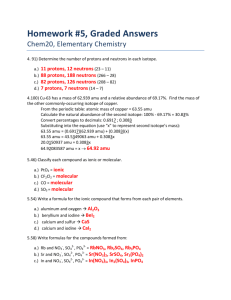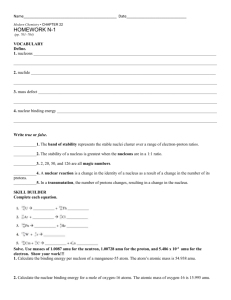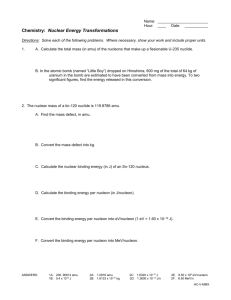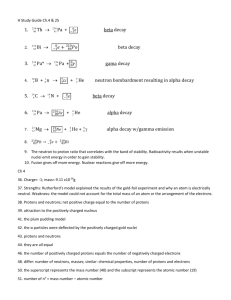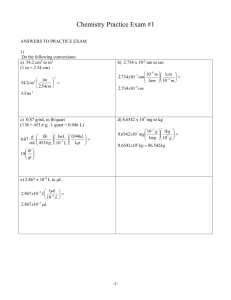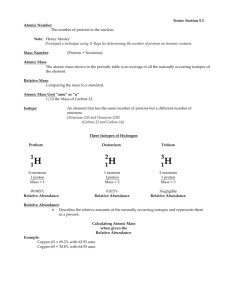21 Nuclear Chemistry
advertisement
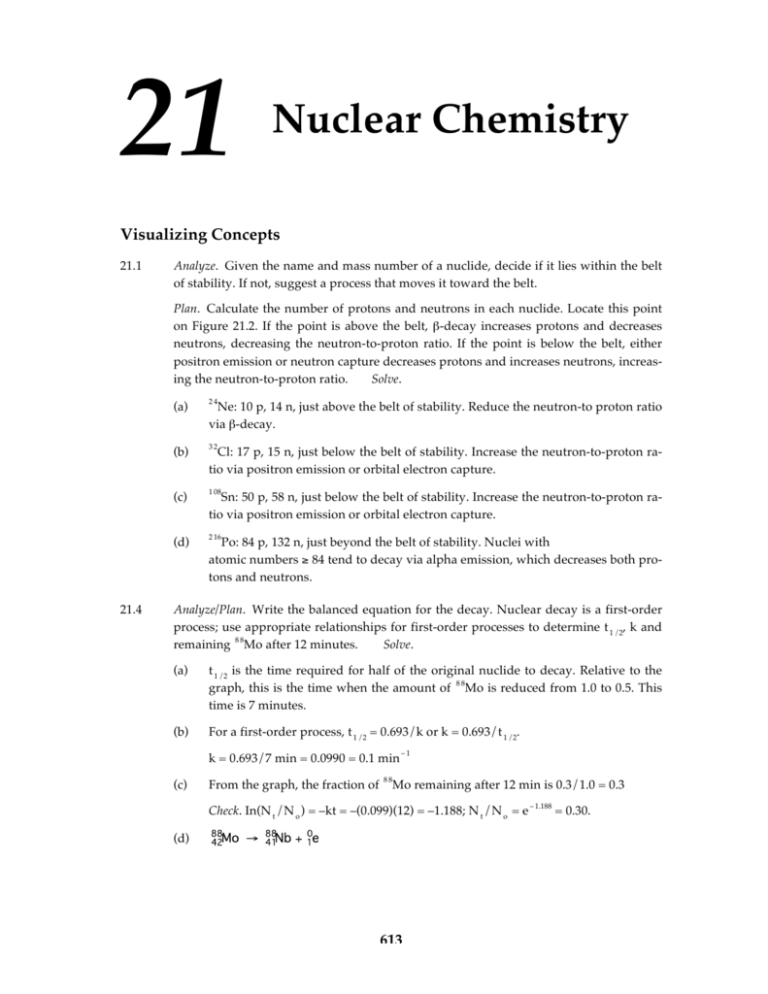
21 Nuclear Chemistry Visualizing Concepts 21.1 Analyze. Given the name and mass number of a nuclide, decide if it lies within the belt of stability. If not, suggest a process that moves it toward the belt. Plan. Calculate the number of protons and neutrons in each nuclide. Locate this point on Figure 21.2. If the point is above the belt, β-decay increases protons and decreases neutrons, decreasing the neutron-to-proton ratio. If the point is below the belt, either positron emission or neutron capture decreases protons and increases neutrons, increasing the neutron-to-proton ratio. Solve. 21.4 (a) 24 (b) 32 (c) 1 08 (d) 2 16 Ne: 10 p, 14 n, just above the belt of stability. Reduce the neutron-to proton ratio via β-decay. Cl: 17 p, 15 n, just below the belt of stability. Increase the neutron-to-proton ratio via positron emission or orbital electron capture. Sn: 50 p, 58 n, just below the belt of stability. Increase the neutron-to-proton ratio via positron emission or orbital electron capture. Po: 84 p, 132 n, just beyond the belt of stability. Nuclei with atomic numbers ≥ 84 tend to decay via alpha emission, which decreases both protons and neutrons. Analyze/Plan. Write the balanced equation for the decay. Nuclear decay is a first-order process; use appropriate relationships for first-order processes to determine t 1 /2, k and 88 remaining Mo after 12 minutes. Solve. (a) t 1 /2 is the time required for half of the original nuclide to decay. Relative to the 88 graph, this is the time when the amount of Mo is reduced from 1.0 to 0.5. This time is 7 minutes. (b) For a first-order process, t 1 /2 = 0.693/k or k = 0.693/t 1 /2. k = 0.693/7 min = 0.0990 = 0.1 min (c) From the graph, the fraction of –1 88 Mo remaining after 12 min is 0.3/1.0 = 0.3 Check. In(N t /N o ) = –kt = –(0.099)(12) = –1.188; N t /N o = e (d) 613 – 1.188 = 0.30. 21 Nuclear Chemistry Solutions to Exercises Radioactivity 21.7 Analyze/Plan. Given various nuclide descriptions, determine the number of protons and neutrons in each nuclide. The left superscript is the mass number, protons plus neutrons. If there is a left subscript, it is the atomic number, the number of protons. Protons can always be determined from chemical symbol; all isotopes of the same element have the same number of protons. A number following the element name, as in part (c) is the mass number. Solve. p = protons, n = neutrons, e = electrons; number of protons = atomic number; number of neutrons = mass number – atomic number (a) 21.9 (b) 21.13 21.15 Hg: 80p, 121n (c) 39 K: 19p, 20n Analyze/Plan. See definitions in Section 21.1. In each case, the left superscript is mass number, the left subscript is related to atomic number. Solve. (a) 21.11 2 01 (b) (c) Analyze/Plan. Follow the logic in Sample Exercises 21.1 and 21.2. Pay attention to definitions of decay particles and conservation of mass and charge. Solve. (a) (b) (c) (d) Analyze/Plan. Using definitions of the decay processes and conservation of mass number and atomic number, work backwards to the reactants in the nuclear reactions. Solve. (a) (b) (c) (d) Analyze/Plan. Given the starting and ending nuclides in a nuclear decay sequence, we are asked to determine the number of alpha and beta emissions. Use the total change in A and Z, along with definitions of alpha and beta decay, to answer the question. Solve. The total mass number change is (235–207) = 28. Since each α particle emission decreases the mass number by four, whereas emission of a β particle does not correspond to a mass change, there are 7 α particle emissions. The change in atomic number in the series is 10. Each α particle results in an atomic number lower by two. The 7 α particle emissions alone would cause a decrease of 14 in atomic number. Each β particle emission raises the atomic number by one. To obtain the observed lowering of 10 in the series, there must be 4 β emissions. Nuclear Stability 21.17 Analyze/Plan. Follow the logic in Sample Exercise 21.3, paying attention to the guidelines for neutron-to-proton ratio. Solve. (a) - low neutron/proton ratio, positron emission (for low atomic numbers, positron emission is more common than orbital electron capture) 614 21 Nuclear Chemistry (b) (c) (d) 21.19 Solutions to Exercises - high neutron/proton ratio, beta emission - slightly high neutron/proton ratio, beta emission - high neutron/proton ratio, beta emission Analyze/Plan. Use the criteria listed in Table 21.3. (a) Stable: odd proton, even neutron more abundant than odd proton, odd neutron; 20 neutrons is a magic number. (b) Stable: odd proton, even neutron more abundant than odd proton, odd neutron; 126 neutrons is a magic number. (c) Stable: even proton, even neutron more likely to be stable than even proton, odd neutron; 21.21 21.23 Solve. has high neutron/proton ratio Analyze/Plan. For each nuclide, determine the number of protons and neutrons and decide if they are magic numbers. Solve. (a) , both (b) (c) , both (d) has a magic number of protons, but not neutrons has neither (e) , both Consider the stability of the two emitted particles. The alpha particle, , has a magic number of both protons and neutrons. The proton bas no magic numbers, and is an odd proton – even neutron particle. The alpha is a very stable emitted particle, which makes alpha emission a favorable process. The proton is not a stable emitted particle and its formation does not encourage proton emission as a process. Nuclear Transmutations 21.25 Protons and alpha particles are positively charged and must be moving very fast to overcome electrostatic forces which would repel them from the target nucleus. Neutrons are electrically neutral and not repelled by the nucleus. 21.27 Analyze/Plan. Determine A and Z for the missing particle by conservation principles. Find the appropriate symbol for the particle. Solve. (a) (b) (c) (d) (e) 21.29 Analyze/Plan. Follow the logic in Sample Exercise 21.5, paying attention to conservation of A and Z. Solve. (a) (b) (c) 615 21 Nuclear Chemistry Solutions to Exercises Rates of Radioactive Decay 21.31 21.33 (a) True. k = 0.693/t1/2. The decay rate constant, k, and half-life, t1/2 are inversely related. (b) False. If X is not radioactive, it does not spontaneously decay and its half-life is essentially infinity. (c) True. Changes in the amount of A would be measurable over the 40-year time frame, while changes in the amount of X would be very small and difficult to detect. Analyze/Plan. The half-life is 12.3 yr. Use t1/2 to calculate k and the mass remaining after 100 yr. Solve. After 12.3 yr, one half-life, there are 1/2(56.2) = 28.1 mg remaining. k = 0.693/ t 1 /2 = 0.693/12.3 yr = 0.056341 = 0.0563 yr = 21.35 kt; lnNt – lnNo = 1 kt; lnNt + lnNo lnN100 = 0.056341 yr 1(100 yr) + ln 56.2 mg lnN100 = 5.6341 + 4.0289 = 1.60522; N100 = 0.201 mg Analyze/Plan. We are given half-life of cobalt-60, and replacement time when the activity of the sample is 75% of the initial value. Consider the rate law for (first-order) nuclear decay: ln(Nt/No) = −kt. Solve. (a) –1 k = 0.693 / t 1 /2 = 0.693/5.26 yr = 0.1317 = 0.132 yr ; Nt/No = 0.75 2.18 yr = 26.2 mo = 797 d. The source would have been replaced sometime in the summer of 2008, probably in August. 21.37 (b) Even at 75% of initial activity, decommissioned medical samples are quite radioactive. These so-called “sources” should be encased in a material such as lead that readily absorbs gamma-rays. Since the half-life is relatively short, they can be housed in a safe, remote storage facility until they are no longer active, and then treated as traditional metal waste. This can be (and usually is) the same facility that stores spent fuel from nuclear reactors. (a) Analyze/Plan. 2 26 2 26 1 α particle is produced for each Ra that decays. Calculate the mass of Ra remaining after 1.0 min, calculate by subtraction the mass that has decayed, and use Avogadro’s number to get the number of –1 Calculate k in min . 616 particles. Solve. 21 Nuclear Chemistry Solutions to Exercises (don’t round here!) [ is a number very close to 1. In this calculation, it is conveneint to ex–9 press the number as (1 – 4.1 × 10 )]. N t = 10.0 × 10 10.0 × 10 –3 –3 –9 g (1.00 – 4.1 × 10 ) The amount that decays is N o – N t : g – [10.0 × 10 –3 –9 (1.00 – 4.1 × 10 )] = 10.0 × 10 –3 –9 g (4.1 × 10 ) = ~4.1 × 10 – 11 g Ra (In terms of sig figs, [N o – N t ] is a very small number, found by subtracting two numbers known only to two sig figs and one decimal place. At best, we can express the result as an order of magnitude.) = 1.1 × 10 (b) 21.39 11 = ~ 10 11 α particles emitted in 5.0 min Plan. The result from (a) is disintegrations/5.0 min. Change this to dis/s and ap10 ply the definition 1 Ci = 3.7 × 10 dis/s. Analyze/Plan. Calculate k in yr N t = 9.7/min/g. Solve. –1 and solve Equation [21.19] for t. N o = 16.3/min/g, k = 0.693/t 1 /2 = 0.693/5715 yr = 1.213 × 10 21.41 –4 = 1.21 × 10 –4 yr –1 Analyze/Plan. Follow the procedure outlined in Sample Exercise 21.7. If the mass of 40 Ar is 4.2 times that of 40K, the original mass of 40K must have been 4.2 + 1 = 5.2 times the amount of 40K present now. Solve. 9 k = 0.693/1.27 × 10 yr = 5.457 × 10 – 10 = 5.46 × 10 617 – 10 yr –1 21 Nuclear Chemistry Solutions to Exercises Energy Changes 21.43 Analyze/Plan. Given an energy change, find the corresponding change in mass. Use Eq2 uation [21.22], E = mc . Solve. 2 2 2 ΔE = c Δm; Δm = ΔE/c ; 1 J = kg - m /s 21.45 2 Analyze/Plan. Follow the logic in Sample Exercise 21.9. Given the mass of an 27Al atom, subtract the mass of 13 electrons to get the mass of an 27Al nucleus. Calculate the mass difference between the 27Al nucleus and the separate nucleons, convert this to energy using Equation [21.22]. Use the molar mass of 27Al to calculate the energy required for 100 g of 27Al. Solve. The mass of an electron is 5.485799 × 10−4 amu (inside back cover of the text). The mass of a 27Al nucleus is then 26.9815386 amu −13(5.485799 × 10−4 amu ) = 26.9744071 amu. Δm = 13(1.0072765 amu) + 14(1.0086649 amu) − 26.9744071 amu = 0.2414960 amu. ΔE = (2.9979246 × 108 m/s)2 × 0.2414960 amu × = 3.604129 × 10−11 = 3.604129 × 10−11 J/27Al nucleus required If the mass change for a single mole of 27Al is 0.2414960 g. 27 Al nucleus is 0.2414960 amu, the mass change for 1 13 10 = 8.044234 × 10 J = 8.044234 × 10 kJ/ 1 0 0 g 21.47 27 Al Analyze/Plan. In each case, calculate the mass defect (Δm), total nuclear binding energy and then binding energy per nucleon. Solve. (a) Δm = 6(1.0072765) + 6(1.0086649) – 11.996708 = 0.0989404 = 0.098940 amu = 1.476604 × 10 – 11 = 1.4766 × 10 – 11 J binding energy/nucleon = 1.476604 × 10 (b) – 11 – 12 J/nucleon Δm = 17(1.0072765) + 20(1.0086649) – 36.956576 = 0.3404225 = 0.340423 amu = 5.080525 × 10 – 11 = 5.08053 × 10 – 11 J binding energy/ nucleon = 5.080525 × 10 (c) J/12 = 1.2305 × 10 – 11 J / 37 = 1.37312 × 10 – 12 J/nucleon Calculate the nuclear mass by subtracting the electron mass from the atomic 618 21 Nuclear Chemistry mass. Solutions to Exercises 102.905504 amu – 45(5.485799 × 10 –4 amu) = 102.880818 amu Δm = 45(1.0072765) + 58(1.0086649) – 102.880818 = 0.9491888/0.949189 amu = 1.416586 × 10 – 10 = 1.41659 × 10 – 10 J binding energy/nucleon = 1.416586 × 10 21.49 – 10 J/103 = 1.37533 × 10 – 12 J/nucleon Analyze/Plan. Use Equation [21.22] to calculate the mass equivalence of the solar radiation. Solve. (a) (b) Analyze/Plan. Calculate the mass change in the given nuclear reaction, then a 2 35 conversion factor for g U to mass equivalent. Solve. Δm = 140.8833 + 91.9021 + 2(1.0086649) – 234.9935 = –0.19077 = –0.1908 amu Converting from atoms to moles and amu to grams, it requires 1.000 mol or 235.0 g 2 35 U to produce energy equivalent to a change in mass of 0.1908 g. 5 2 5 0.10% of 1.714 × 10 kg is 1.714 × 10 kg = 1.714 × 10 g (This is about 230 tons of 21.51 2 35 U per day.) We can use Figure 21.13 to see that the binding energy per nucleon (which gives rise to the mass defect) is greatest for nuclei of mass numbers around 50. Thus (a) should possess the greatest mass defect per nucleon. Effects and Uses of Radioisotopes 21.53 (a) NaI is a good source of iodine, because it is a strong electrolyte and completely dissociated into ions in aqueous solution. The I−(aq) are mobile and immediately available for bio-uptake. They do not need to be digested or processed in the body before uptake can occur. Also, iodine is a large percentage of the total mass of NaI. (b) After ingestion, I−(aq) must enter the bloodstream, travel to the thyroid and then be absorbed. This requires a finite amount of time. A Geiger counter placed near the thyroid immediately after ingestion will register background, then gradually increase in signal until the concentration of I−(aq) in the thyroid reaches a maximum. Then, over time, iodine-131 decays, and the signal decreases. (c) Analyze/Plan. The half-life of iodine-131 is 8.02 days. Use t1/2 to calculate the de- 619 21 Nuclear Chemistry Solutions to Exercises cay rate constant, k. Then solve Equation [21.19] for t. No = 0.12 (12% of ingested iodine absorbed); Nt = 0.0001 (0.01% of the original ingested amount). Solve. k = 0.693 t1/2 = 0.693/8.02 d = 0.086409 = 0.0864 d−1 ln(Nt/No) = −kt; t = −ln(Nt/No)/k = 82.05 = 82 d Check. Nt is given to 1 sig fig, so 8 × 101 (70 – 90) days is a more correct representation of the time frame for decay. 21.55 21.57 (a) In a chain reaction, one neutron initiates a nuclear transformation that produces more than one neutron. The product neutrons initiate more transformations, so that the reaction is self-sustaining. (b) Critical mass is the mass of fissionable material required to sustain a chain reaction so that only one product neutron is effective at initiating a new transformation. (a) (b) 21.59 21.61 (a) The extremely high temperature is required to overcome the electrostatic charge repulsions between the nuclei so that they come together to react. (b) The sun is not solid. No element or compound is solid at temperatures of 1,000,000 to 10,000,000 K. Analyze/Plan. Hydroxyl radical is electrically neutral but has an unpaired electron, − •OH. Hydroxide is an anion, OH . Solve. Hydrogen abstraction: RCOOH + •OH → RCOO• + H2O RCOOH + OH− → RCOO− + H2O Deprotonation: Hydroxyl radical is more toxic to living systems, because it produces other radicals when it reacts with molecules in the organism. This often starts a disruptive chain of reactions, each producing a different free radical. – Hydroxide ion, OH , on the other hand, will be readily neutralized in the buffered cell environment. Its most common reaction is ubiquitous and innocuous: + – – H + OH → H 2 O. The acid-base reactions of OH are usually much less disruptive to the organism than the chain of redox reactions initiated by •OH radical. 21.63 Analyze/Plan. Use definitions of the various radiation units and conversion factors to calculate the specified quantities. Pay particular attention to units. Solve. (a) 1 Ci = 3.7 × 10 10 disintegrations(dis)/s; 1 Bq = 1 dis/s 620 21 Nuclear Chemistry Solutions to Exercises –2 (b) 1 rad = 1 × 10 J/kg; 1 Gy = 1 J/kg = 100 rad. From part (a), the activity of the 8 source is 5.3 × 10 dis/s. (c) rem = rad (RBE); Sv = Gy (RBE) , where 1 Sv = 100 rem 2 3 3 mrem = 6.14 × 10 mrad (9.5) = 5.83 × 10 = 5.8 × 10 mrem (or 1.5 rem) Sv = 6.14 × 10 –3 Gy (9.5) = 5.83 × 10 –2 = 5.8 × 10 –2 Sv Additional Exercises 21.65 This corresponds to a reduction in mass number of (3 × 4 =) 12 and a reduction in atomic number of (3 × 2 – 2) = 4. The stable nucleus is (This is part of the se- quence in Figure 21.5.) 21.69 (a) (b) (c) (d) 21.73 The bond of the acid and the bond of the alcohol break in this reaction. 18 18 Initially, O is present in the group of the alcohol. In order for O to end up in the ester, the bond of the alcohol must break. This requires that the bond in the acid also breaks. The unlabeled O from the acid ends up in the H 2 O product. 21.75 Because of the relationship ΔE = Δmc , the mass defect (Δm) is directly related to the binding energy (ΔE) of the nucleus. 2 7 Be: 4p, 3n; 4(1.0072765) + 3(1.0086649) = 7.05510 amu Total mass defect = 7.0551 – 7.0147 = 0.0404 amu 0.0404 amu/7 nucleons = 5.77 × 10 –3 amu/nucleon 621 21 Nuclear Chemistry 9 Solutions to Exercises Be: 4p, 5n; 4(1.0072765) + 5(1.0086649) = 9.07243 amu Total mass defect = 9.0724 – 9.0100 = 0.06243 = 0.0624 amu 0.0624 amu/9 nucleons = 6.937 × 10 6.937 × 10 –3 –3 = 6.94 × 10 amu/nucleon × 1.4925 × 10 – 10 –3 amu/nucleon J/amu = 1.035 × 10 – 12 = 1.04 × 10 – 12 J/nucleon 10 Be: 4p, 6n; 4(1.0072765) + 6(1.0086649) = 10.0811 amu Total mass defect = 10.0811 – 10.0113 = 0.0698 amu 0.0698 amu/10 nucleons = 6.98 × 10 6.98 × 10 –3 –3 amu/nucleon amu/nucleon × 1.4925 × 10 – 10 J/amu = 1.042 × 10 9 The binding energies/nucleon for Be and higher. – 12 = 1.04 × 10 10 Be are very similar; that for – 12 J/nucleon 10 Be is slightly Integrative Exercises 21.81 Calculate the amount of energy produced by the nuclear fusion reaction, the enthalpy of combustion, ΔH°, of C 8 H 1 8 , and then the mass of C 8 H 1 8 required. = 0.027583 = 0.02758 amu = 4.11654 × 10 = 6.1495 × 10 11 – 12 = 4.117 × 10 8 – 12 1 J/4 H nuclei 1 J = 6.1 × 10 kJ produced by the fusion of 1.0 g H. C8H18(l) + 25/2O2(g) → 8CO2(g) + 9H2O(g) ΔH° = 8(−393.5 kJ) + 9(–241.82 kJ) – (–250.1 kJ) = −5074.3 kJ 14,000 kg C 8 H 1 8 (l) would have to be burned to produce the same amount of energy as fu1 sion of 1.0 g H. 622

